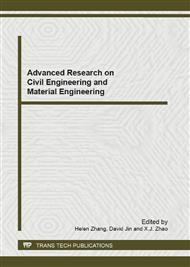p.66
p.71
p.76
p.80
p.85
p.89
p.94
p.99
p.103
Seismic Damage Analysis and the Study of Reinforcement Measures for RC Frame Structure Building in Civil Engineering
Abstract:
In 5·12 Wenchuan earthquake, most of the buildings were damaged at different degrees in Mianyang. To analysis seismic damage of RC frame structure building, and investigate its reinforcement situation,the results show that: For destruction of frame column or bottom frame structure column, enlarge section method is used mostly for reinforcement in civil engineering;To serious damage of affiliated structure such as filler wall and Parapet, most of them will be demolished and built again, and add constructional column; To the situation of concrete bottom plate with crack, paste carbon fiber sheet or bottom plant steel was used depending on the structural damage degree, and jet concrete for strengthening.
Info:
Periodical:
Pages:
85-88
Citation:
Online since:
September 2012
Authors:
Price:
Сopyright:
© 2012 Trans Tech Publications Ltd. All Rights Reserved
Share:
Citation:


